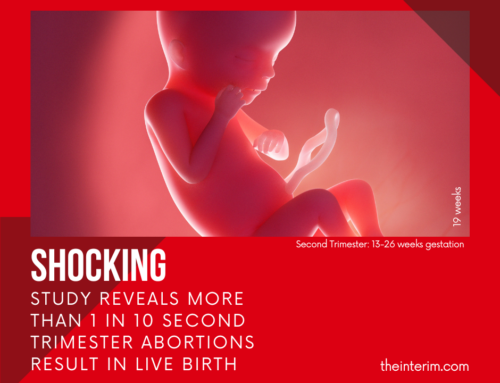With a vote of 140 against 131, Canada’s House of Commons approved Bill C-43 on May 29, 1990. The Bill states that abortions may be performed for life and health reasons. The term “health” covers physical, mental and psychological reasons. An accompanying guideline notes that social and economic reasons are also to be included under this heading.
The government of Prime Minister Brian Mulroney stomped on every attempt to tighten the bill even to the point of forbidding its own Parliamentary Committee to introduce amendments after holding eight weeks of hearings on the issue.
The new Bill legalizes abortion on demand and, in fact, raises the American-invented “right to privacy” to the level of high legal principle in Canada. Feminists claim that this principle justifies and incorporates a woman’s “right” to kill her baby still in the womb. The Bill confirms this, if not in theory, then in practice.
Although the Bill placed abortion in the Canadian Criminal Code, this was only done to ward off non-medical personnel from doing abortions and to prevent provinces from regulating abortions under Health legislation, which is a provincial jurisdiction.
Two Ministers of Justice in a row have solemnly assured the Canadian Medical Association that no licensed medical doctor will ever be prosecuted under this section of the Code. And one can see why: in Canada abortions are now legal for any reason; they are no longer restricted to hospitals but may be done anywhere, including doctors’ offices; and they may be done at any time of the pregnancy right up until birth. The country stands with China as having the most wide-open abortion law in the world. Unlike China, of course, it does not yet publicly force women to get abortions though it was revealed last December that in the Canadian Army women soldiers are virtually ordered to have them, or face being dismissed.
In addition to being legal, abortions are also fully funded by provincial health insurance despite the fact that everyone knows that abortion is not a question of health.
How did it get this far? Canada first gave parliamentary approval to abortion under Prime Minister Pierre Trudeau in 1969. At that time abortions were restricted to those hospitals which agreed to do them; they had to be approved by a three-doctor hospital committee; and they were to be done only for serious reasons of life and health.
Subsequent practice favoured a wide-open interpretation of the health clause. This led to growing numbers of abortions though they never reached the epidemic proportions of abortions in the United States. A number of hospitals, mostly Catholic, refused to perform abortion, making a significant difference in a country where almost 50 per cent of the people are Catholics, at least nominally.
Following the 1969 legislation, the notorious Henry Morgentaler of Montreal succeeded over the years in setting up private “clinics,” first in Quebec, then in Ontario. These were directly contrary to federal law but found silent or open approval by provincial authorities. Moreover, juries refused to convict him when brought to trial.
Morgentaler’s Toronto jury acquittal of November 1984 was appealed all the way to the top. The Ontario Supreme Court overthrew it in a unanimous decision in October 1985. But the Canadian Supreme Court dismissed the case in January 1988, on the grounds that the conditions set by the 1969 Act were contrary to the Canadian Charter of Rights and Freedoms. Thus Morgentaler won by default and Canada found itself without a law on abortion.
After some brave words immediately after the ruling, Mulroney’s Conservative government avoided the issue for almost two years. Two court rulings in Ontario and Quebec in the summer of 1989 brought about a change.
Two young fathers won court rulings forbidding their girlfriends from seeking abortions. The outcry of the (pro-abortion) media was such that Prime Minister Brian Mulroney hurriedly decided to act.
Mr. Mulroney is a fluently bilingual Irish Quebecker. He is a Catholic, like his predecessors Pierre Trudeau (Liberal Prime Minister, 1968-1984), Joe Clark (Conservative Prime Minister for nine months in 1979), and John Turner (Liberal Prime Minister for six weeks in 1984). Like the others, he has stoutly ignored all arguments against abortion and its legalization, whether biological, philosophical, sociological or theological, all the while claiming or pretending to be a personally opposed.
In September of 1989, the Prime Minister made the decision to join the feminist, pro-abortion cause as the politically wise course to take. He abandoned all former hesitation, issuing direct orders to all members of the Cabinet and their parliamentary secretaries to fall in line behind the Bill. Backbenchers too, were given to understand their careers in a Mulroney Conservative part would not be prominent unless they did as told.
The two national pro-life organizations, Campaign Life Coalition and Alliance for Life, fought the Bill vigorously, bombarding Members of Parliament with letters, telegrams, phone calls and personal encounters. The effort proved in vain for two reasons.
A number of long-time traditional Conservative pro-life Members of Parliament decided to opt for politics over principle, thus, as one writer put it “deeply hurting those who saw them as their best hope to end, or at least slow down, the wanton slaughter of the unborn.”
Among these leaders were Energy Minister Jake Epp (Mennonite) and Industry Minister Benoit Bouchard (Catholic), two men who had been considered among the strongest pro-life politicians.
The other disappointment – perhaps even more bitter to swallow than the desertion of the politicians – was the attitude of the Canadian Conference of Catholic Bishops. This was expressed in a Brief to the government in January 1990.
To the astonishment of the pro-lifer, the Bishops commended the government “for its thoughtful approach.”
“We recognize,” they went on to say, “That there are strongly held views which differ from ours.” To this they added that: “authentic pluralism…means that no one group has the right to impose its particular point of view.” As for Christian legislators, they said, they must make their own decisions. The norm of their actions as legislators is not chiefly the good of any religious group but the good of society.
While “Catholics may not dissent from the Church teaching that abortion is morally wrong,” they added, “when it is the only available or feasible political option, support may be given to legislation which attempts, if only imperfectly, to restore protection or strengthen existing protection.”
Pro-life leaders were baffled by the Bishops crediting government efforts and pro-abortion arguments as seemingly valid and honorable. Furthermore, they rejected the Bishops’ reference to pluralism as having no bearing on the rights of the unborn. They quoted the 1980 Vatican Declaration on Euthanasia:
“Since it is a question here of fundamental rights inherent in every person, it is obviously wrong to have recourse to arguments from political pluralism or religious freedom in order to deny the universal value of those rights.” Again contrary to the view of the Bishops’ Conference, pro-lifers held that Bill C-43 was not the “only available or feasible political option,” but was rather, a new second approval of abortion in principle, and abortion on demand at that. Therefore, they said, every legislator and certainly every Catholic legislator should have been told that they could not in conscience vote for this Bill.
Pro-lifers hold that the Bishops should have explained the moral obligations of the Christian instead of trying to fill the role of politician and lawyer. But with the Bishops taking the view that any law is better than no law, there was no rallying cry from spiritual leaders nor was there a crusade of prayers on behalf of a just law. If there had been such a cry and crusade, the 140-131 votes in favor of the Bill could easily have been reversed.



